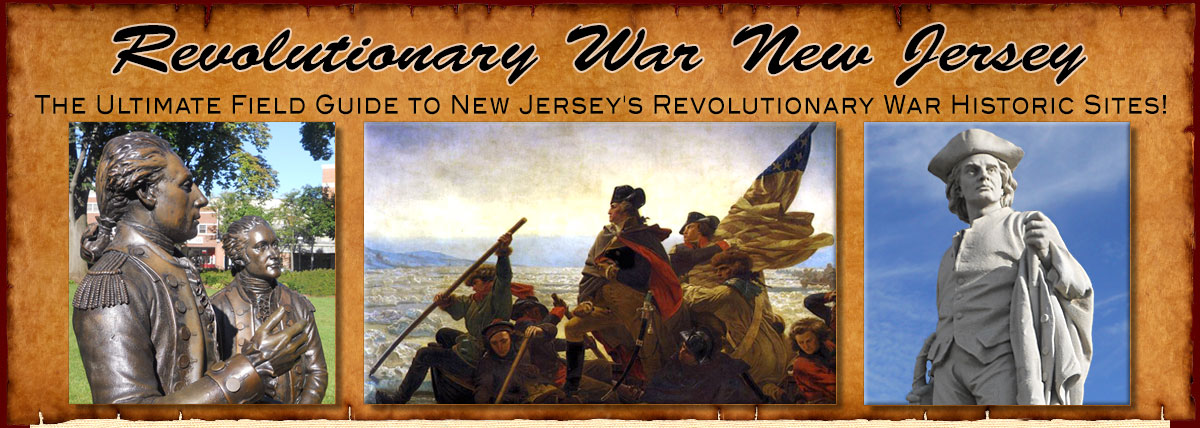

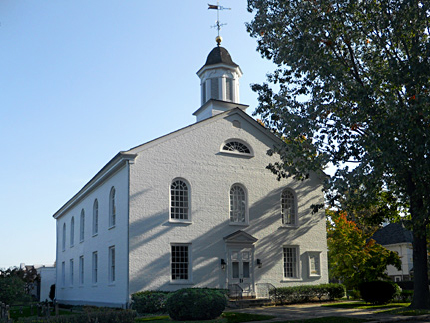
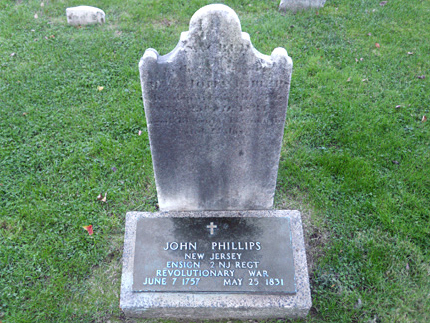
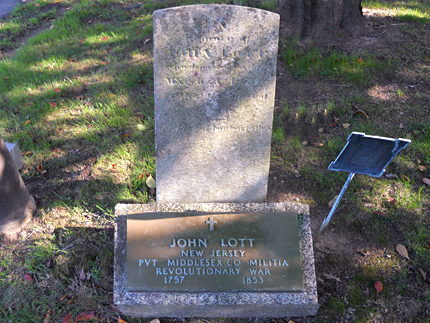
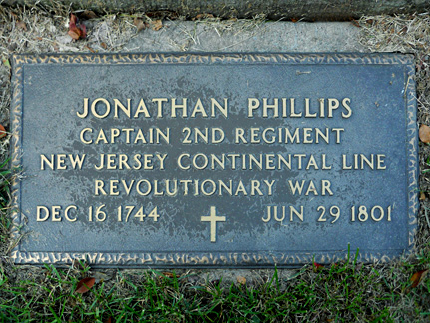
The Presbyterian Church of Lawrenceville
2688 Main St.
Map / Directions to the Presbyterian Church of Lawrenceville
Map / Directions to all Lawrence Township Revolutionary War Sites
This church was built in 1764 and enlarged in 1853. It stands at the site of an earlier Presbyterian meetinghouse, which was built in the early 1700's. [1] John Hart, a signer of the Declaration of Independence, was baptized at that earlier meetinghouse on March 4, 1714 (O.S. Dec. 21, 1713). [2] Throughout this time period, this area was known as Maidenhead, until the name was changed to Lawrence Township in 1808. [3]
There are at least five Revolutionary War soldiers buried in the cemetery: [4]
Benjamin Hunt
Private, 1st Regiment NJ Militia
John Lott
(1757- 1853)
Private, Middlesex County Militia
John Phillips
(June 7, 1757- May 25, 1831)
Ensign, 2nd NJ Regiment
Jonathan Phillips
(December 16, 1744 - June 29, 1801)
Captain, 2nd Regiment, NJ Continental Line
Joseph Phillips
(1718 -1788)
Colonel, 1st Regiment, NJ Militia

Five Mile Run Marker
Rte. 206 (Lawrenceville Rd.) near Shelmet Ln.
Next to Turtleback Park
Map / Directions to Five Mile Run
Map / Directions to all Lawrence Township Revolutionary War Sites
Shabakunk Creek
Route 206 (Lawrenceville Rd.),
Next to Notre Dame High School
Map / Directions to Shabakunk Creek
Map / Directions to all Lawrence Township Revolutionary War Sites
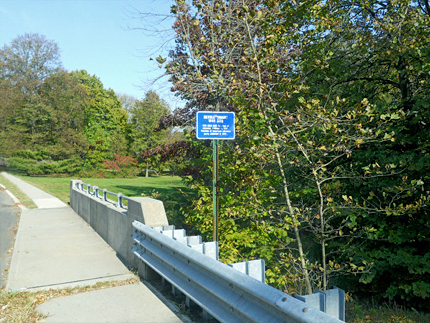
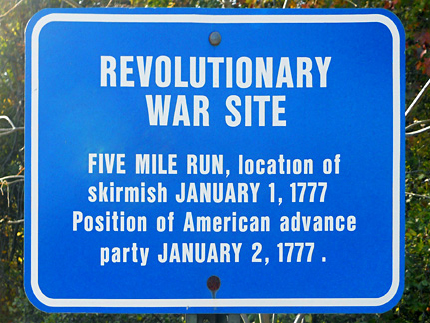
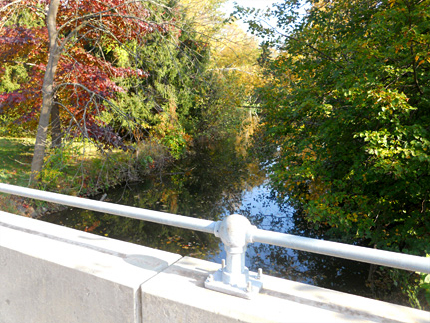
Before the Second Battle of Trenton, American troops skirmished with British and Hessian forces along this road.
American General James Wilkinson, who was at the time of the Second Battle of Trenton a Major, wrote about these events in his Memoirs: [5]
"Major Henry Miller of the rifle corps, had charge of the guards of our advance, on the night of the first, and about 12 o'clock, in returning from the rear to the front, he met General Fermoy on his way to Trenton; the enemy were in motion early on the 2d, and about sunrise, a mounted yager, belonging to the advanced patrole, in pursuit of a citizen of the name of Hunt, ran in upon our picket at Maidenhead, and was shot from his horse. On hearing this shot, the advanced party at Five Mile run, stood to their arms, but missing the General, some embarrassment ensued, which was soon removed by Major Miller, and Colonel Hand took the command of the troops, and retired leisurely before the enemy, until orders were received from the commander in chief [General George Washington], to dispute every inch of the ground where practicable; Colonel Hand then faced about, and advanced to meet the enemy, when a skirmish commenced, that was continued at intervals throughout the day, in which Colonel Hand's riflemen and Captain Forest's artillery were particularly distinguished."
Wilkinson's story continues in the next entry below, about Shabakunk Creek

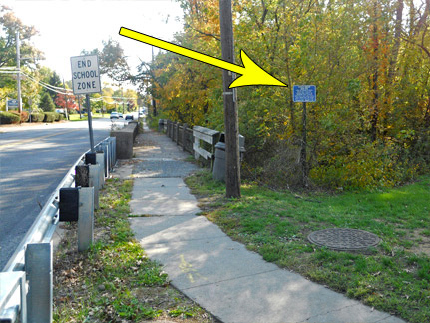
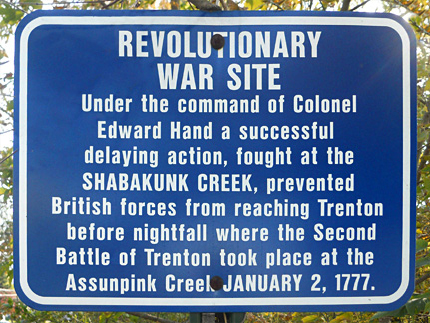
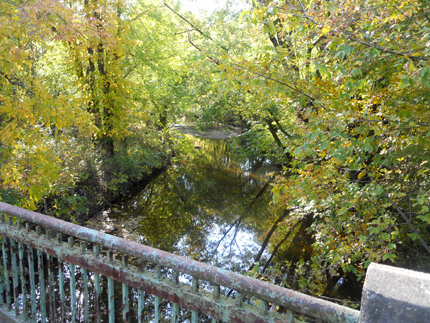
Continuing the story from James Wilkinson's Memoirs: [6]
(Note that Wilkinson spells Shabakunk as "Shabbakong")
"The right bank of the rivulet of Shabbakong was at that period covered with a close wood a mile in depth, whilst the opposite side presented open fields; Colonel Hand, who brought up the rear with his riflemen, determined to waste as much time as possible for the enemy at this point; he accordingly secreted his men distance within the wood, on the flanks of the road, posting Major Miller on the left, and in person taking command on the right: in this position he waited for the flank and advanced guards of the enemy, until they came within point blank shot, and then he opened a deadly fire from his ambush, which broke and forced them back in great confusion on the main body, closely pursued by the riflemen. The boldness of this manoeuvre menacing a general attack, induced the enemy to form in order of battle, to bring up his artillery, and open a battery with which he scoured the wood for half an hour before he entered it; this operation consumed two hours, during which time the rifle corps took breath, and were ready to renew the skirmish. The brigade of General St. Clair, with two pieces artillery, I think under Captain Sergeant, were as to the defence of the fords of the Assanpink, on the right of our line: the enemy's flankers reconnoitred those fords, but finding them guarded, joined their main body: my station gave me a fair view of the left flank of the enemy's column, after it had passed the wood from Shabbakong, and wheeled to their right on the margin of the high ground, which leads to Trenton. About half a mile advanced from the northern extremity of the buildings of this place, on the old road to Princeton, there is a ravine, which crosses the road at right angles, and descends to the plain of Assanpink; on the south-western verge of this hollow, our advance party made their last stand, in which the Virginia troops, under Colonels Scott and Lawson and Majors Josiah and Richard Parker, with Forest and his field pieces, distinguished themselves.
"The battery, covered by about six hundred men, opened on the column of the enemy, and was presently answered by a counter-battery; the cannonade continued twenty or twenty-five minutes, when the British column was partially displayed, and advanced in line: the firing of the musketry was soon mingled with that of the artillery, but the enemy preserved his front, and being of threefold numbers, continued to advance until he forced our corps to retire by the bridge across the Assanpink. I had a fair flank view of this little combat from the opposite side of the Assanpink, and recollect perfectly the sun had set, and the evening was so far advanced that I could distinguish the flame from the muzzles of our muskets. Anterior to this skirmish. General Washington, who stood fairly committed to a general action, if the enemy had pressed it, feeling how important it was to retard the march of the enemy until nightfall, rode up to the advanced party with Generals Greene and Knox, thanked the detachment, and particularly the artillery, for the services of the day, gave orders for as obstinate a stand as could be made on that ground, without hazarding the pieces, and retired to marshal his troops for action behind the Assanpink.
"After forcing our advanced party, the enemy took post in our front, at about 1000 yards distance, with the intervention of the village (now city) of Trenton, and the Assanpink creek, which was every where fordable below the mill: a cannonade ensued between the two armies with little effect, during which Lord Cornwallis displayed his columns, and extended his lines, to the westward, on the heights above the town. If there ever was a crisis in the affairs of the revolution, this was the moment; thirty minutes would have sufficed to bring the two armies into contact, and thirty more would have decided the combat; and, covered with wo, Columbia might have wept the loss of her beloved chief and most valorous sons. In this awful moment, the guardian angel of our country admonished Lord Cornwallis, that his own troops were fatigued, and that the Americans were with out retreat; and under this impression, he addressed his general officers, 'the men had been under arms the whole day; they were languid and required rest; he had the enemy safe enough, and could dispose of them the next morning; for these reasons he proposed that the troops should make fires, refresh themselves, and take repose.' General Grant, his second, acquiesced, and others followed, but Sir William Erskine exclaimed, 'My Lord, if you trust those people to-night. you will see nothing of them in the morning."' This admonition was not regarded, and the enemy made their fires and went to supper, as we did also, our advanced sentries being posted within 150 yards of each other. Between this situation of the armies of General Washington and Lord Cornwallis on the 2d of January, and those of General Burgoyne and General Gates on the 20th of September following, a striking analogy is perceptible in the most important incidents, and we discover in the events by what trivial circumstances the destinies of armies and of states are controlled."

1. ^ History page of the Presbyterian Church of Lawrenceville website
2. ^ Cleon E. Hammond, John Hart - The Biography of a Signer of the Declaration of Independence (Newfane, VT: The Pioneer Press, 1977) page 4 and 252
3. ^ John F. Snyder, The Story of New Jersey's Civil Boundaries: 1606-1968 (Trenton: Bureau of Geology and Topography, 1969) pages 162-163
Available as a PDF on the State of New Jersey website here. (Note that although the information is on pages numbered 162-163 of the document, it is on pages 158-159 of the PDF file.)4. ^ Names, dates and military information drawn from grave markers in this cemetery
5. ^ General James Wilkinson, Memoirs of my Own Times, Volume 1 (Philadelphia: Abraham Small, 1816) p.136
Available to be read at Google Books here6. ^ General James Wilkinson, Memoirs of my Own Times, Volume 1 (Philadelphia: Abraham Small, 1816) p.136-139
Available to be read at Google Books here